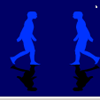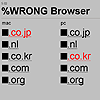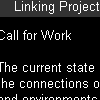 Originally
published
on
09/05/03
Originally
published
on
09/05/03Close your curtains, turn your lights and TVs off, and plug your stereos into your computers because it's time to watch (yes I said watch; minimal interaction required) some new work by Peter Horvath.
Hosted as part of Whitney Artport's monthly changing Gate pages (The Whitney Museum Portal to Net Art), "The Presence of Absence" is a smaller piece (a sort of featured splash screen project) than Peter's previous works, such as "Either side of an empty room," so a comparison isn't necessary here. True to splash screen projects, it's compact and neat (as it should be) but it's certainly not lacking in quality nor style.
Here we investigate a collection of videos that is triggered by clicking on various sections of the face / head (seemingly the artist's) which is used as an interface. Videos seem to be thoughts emanating from that head and splashed across our computers both visually and audibly. Peter's work has been compared to that of Tarkovsky's 'The Mirror' because of its "open-ended qualities" (Clint Roenisch) but this seems to miss another important point: that this is in fact a self portrait of the artist's mind as a layered structure. The thoughts and ideas are accessible non-linearly and disconnected, as much as Tarkovsky's 'The Mirror' is a self portrait of the director through memories of childhood, the Russia of his youth, his mother, sounds, and snow (lots of snow), in no particular order.
"La Fin" comes too soon but this certainly won't be the end of stunning work from Peter Horvath. Expect this "to be continued..."
:: Garrett Lynch ::
 Originally
published
on
09/01/03
Originally
published
on
09/01/03In addition to the announcement below by Eduardo Navas of Dian Network, here are some thoughts about linksites like Dian Network. I would define a linksite as a site whose main function is linking works that do not reside on the site itself. Linksites are a typical Internet phenomenon that are cool and fun sites, especially when you talk about design; and you can find a lot of them.
The bigger ones like linkdup give the linked site an unprecedented load of traffic for a few days. But, unfortunately, there have never been net-art categories on these bigger sites; nor have there been net-art linksites with the popularity of these bigger sites. Though I must admit that there have been dozens of these sites in the early years of the net.
This is opposite nowadays where there's, to my knowledge, only a handful of them. To name but a few: Rhizome's artbase*, artcart, java museum and the Dian Network. Of course, the character and value that these sites add is what's different. You have sites like Dian Network that are a sort of parasite (just a link, no essays, no interviews, etc.), while others have an added value because they put up, for example, more info about the artist or can send a lot of traffic to the linked site.
There's probably no added value nowadays that you can find at sites like Dian Network, which is probably the main reason why most of them vanished. In contrast to the decline of this type of site stands the fact that net artists nowadays are not that eager to link sites of fellow net artists. Reasons for this could be that artists don't like visitors to leave their site or that artists are concentrating so heavily on their own work that they've lost their sense of community--lost because the practice of a lot of early net artists differed. Often, link pages were whole artworks for these artists, like, for example, Jodi's map.
The only thing that I conclude from this is that net artists have changed along with the whole Internet; but, also, that typical Internet phenomena like linksites hardly has a grip on this typical form of art called net art.
*Not linked because you need to be a paid member to get access. For more info about this go to Rhizome.
:: Peter Luining ::
...
Dian Network's feature this month is 1n-0ut by Jim Punk.
:: Eduardo Navas ::
 Originally
published
on
09/07/03
Originally
published
on
09/07/03Not a new piece of work but also not well known (at least to my knowledge), "Wrong Browser" is yet another artist's reinterpretations/misinterpretations of how web browsers should or could work. But don't let this dissuade you from having a look at these small downloadable applications. Applications as art or art as applications, they are some of the most successful examples of this very particular genre of the cross over between net art and application art--"browser art." But is this genre "browser art" or is it us manipulating / dismantling / subverting and totally controlling an existing browser? e.g. the work of "jimpunk."
It's available for Mac (classic only I think) and PC, and well worth downloading. Personal favorite ".org".
:: Garrett Lynch ::
 Originally
published
on
08/28/03
Originally
published
on
08/28/03Here is an upcoming deadline worth noting:
Submit your top ten links to LINKING PROJECT 2003 (deadline extended to November 1st, 2003).
This exhibiting opportunity was previously featured on Net Art Review a few months ago. I am hereby digging out my original post from the archives of June 10, 2003:
--------------------
A few months ago, I watched the movie Scratch by Doug Pray. At one point in the film, DJ Shadow is interviewed and is asked about his obsession with collecting old records; he is simultaneously shown spending his time in a basement of a used record store finding materials for his world famous samples. As a result of his obsession, Shadow is known as 'the king of digging.' Many DJ lifestyles are built on serious music collecting; this is similar to a writer building her vocubulary from book collecting.
Collecting links may be the same for net artists and net enthusiasts. And here is a chance to show off some of the best links from our personal collections:
"Call for Work: Adhocart.org linking project The current state of geo-politics and globalization highlights once again how the connections of our actions resonate and impact other peoples, beings and environments around the world. The Linking Project looks to individuals, with an open call, to trace, through the use of links, relationships that impact bodies of knowledge and how this information filters down to influence global outcomes. Use the links to trace information, construct information, or to exemplify. Use your links to challenge, criticize or celebrate. Please submit up to ten or so links in the form of an HTML page. Include a short description of the linking process or what your links accomplish. Include a brief bio. And optional email contact (for the HTML page.) All linking projects will be accepted. Deadline: Deadline: November 1st, 2003"
For more information contact Andrew Bucksbarg
--------------------
:: Eduardo Navas ::